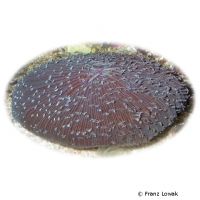Plate Coral (LPS) (Fungia fungites)
| Plate Coral (LPS) Fungia fungites | |
|---|---|
| Name | Plate Coral (LPS) |
| Name Lat. | Fungia fungites |
| Family | Mushroom Corals |
| Family lat. | Fungiidae |
| Order | Stony Corals |
| Order lat. | Scleractinia |
| Origin | Indo-Pacific |
| Diet | Autotrophic, planktivore |
| pH | 8.1-8.4 |
| Hardness | 8-10 °KH |
| Lighting | Medium |
| Current | Weak-moderate |
| Behavior | Semi-aggressive |
| Keeping | Solitary |
| Care Level | Moderate |
| Life Span | N/A |
| Protection | CITES Appendix II; EC Annex B |
| Metric Units | |
| Size | < 30 cm |
| Temperature | 24-27 °C |
| Salinity | 33-36 ‰ |
| Aquarium | 200 l |
| US Units | |
| Size | < 12" |
| Temperature | 75-81 °F |
| Salinity | 1.020-1.025 sg |
| Aquarium | 50 gal |
Distribution and habitat
Fungia fungites belongs to the group of LPS (Large Polyp Scleractinia) and it is widely distributed in the Indian Ocean, the Red Sea and the Central and Western Pacific. This solitary coral is found on inner reefs, shallow slopes and in lagoons at depths of 1-20m. Juveniles are sessile (sessile), adults are free-living. They are usually light brown with purple inclusions.
Maintenance
They should be positioned at the bottom in a sandy place with not too high light intensity and weak to medium current. As a substrate, only lime-rich, heavy metal-free substrates should be used. The aquarium should not lack live stones, which act as a biological filter. To ensure water quality, filters, skimmers and heaters are necessary, as well as pumps to simulate tides, swells and bottom currents. Lighting must correspond to the species-appropriate day-night rhythm of the animals
| Salinity: 33-36 ‰ | pH value: 8.1-8.4 |
| Carbonate hardness: 8-10 °KH | Nitrate content: 2-8 mg/l |
| calcium content: 420-450 mg/l | Nitrite content: 0.0-0.05 mg/l |
| Magnesium content: 1.250-1.350 mg/l | phosphate content: 0.01-0.1 mg/l |
Regular addition of trace elements, especially iodine and strontium, is recommended. For salinity, an average value should be aimed for, which may only vary slightly by +/- 0.5 ‰. Ammonia and ammonium must not be measurable. Special attention shall be paid to consistently good water quality and water values.
Diet
Zooxanthellae, which are unicellular symbiotic algae, live in their tissue and provide them with assimilation products of their photosynthesis (light requirement). The zooxanthellae promote growth and provide additional food to the plankton and small particles that are collected in large quantities from the water current. Thus, in addition to the food produced in the aquarium during fish feeding (mysis, krill, Artemia, etc.), commercially available supplementary food in the form of phyto- and zooplankton should be offered regularly
Regular and varied feeding promotes health and prevents deficiency symptoms.
Behaviour and compatibility
They should not be kept with fish that regard their polyps as food (e.g. emperor or butterfly fish). They are well tolerated with other corals, but sufficient distance must be kept from cnidarians.
Reproduction and breeding
In nature, reproduction is sexual via marine larval stages. A special characteristic of Fungia is that damaged or dying animals can form offshoots (anthocauli formation), which grow on the skeleton of the mother animal.
Species protection
Species protection: WA Appendix II; EU Appendix B. The proof of purchase is the required proof of origin for the animal. Please keep it safe! Your pet store will be happy to provide you with further information.
Important
Dead Fungia should not be removed from the aquarium, as daughter polyps may develop after a few weeks. The additional lighting with actinic light (short-wave, violet-blue light) is very beneficial for their growth (zooxanthellae).
A calcium reactor and magnesium metering pump are recommended for the necessary steady supply of calcium carbonate and magnesium. Too high temperature, insufficient lighting or current as well as sudden change of water values can lead to tissue decay (RTN - rapid tissue necrosis). They are very sensitive and can be easily injured during handling. Newly introduced animals must be acclimated slowly to the water in the aquarium
If different species are kept together, make sure that fish and invertebrates match each other in terms of water quality and temperature requirements as well as their social behavior, and that the setup meets the ecological needs of all species kept together
Further literature can be found in your pet store.
References
Text: petdata; Image: Franz Lowak
Source: VERON (2000): Corals of the world, Australian Institute of Marine Science; ENGELMANN & LANGE (2011): Zootierhaltung - Tiere in menschlicher Obhut: Wirbellose, Verlag Harri Deutsch
